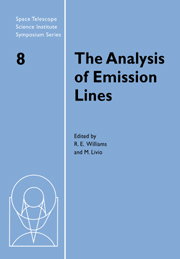Book contents
- Frontmatter
- Contents
- Participants
- Preface
- Emission Lines: Past and Future
- Atomic Data for the Analysis of Emission Lines
- Radiative Transfer
- Emission Lines from Winds
- Photoionizing Shocks
- The Lexington Benchmarks for Numerical Simulations of Nebulae
- Emission Line Diagnostics
- Ultraviolet Spectroscopy
- Infrared Emission Lines as Probes of Gaseous Nebulae
- Molecular Emission Line Diagnostics in Astrophysical Environments
- Abundance Determinations
- Astrophysical Gamma Ray Emission Lines
- Summary Remarks
Molecular Emission Line Diagnostics in Astrophysical Environments
Published online by Cambridge University Press: 23 November 2009
- Frontmatter
- Contents
- Participants
- Preface
- Emission Lines: Past and Future
- Atomic Data for the Analysis of Emission Lines
- Radiative Transfer
- Emission Lines from Winds
- Photoionizing Shocks
- The Lexington Benchmarks for Numerical Simulations of Nebulae
- Emission Line Diagnostics
- Ultraviolet Spectroscopy
- Infrared Emission Lines as Probes of Gaseous Nebulae
- Molecular Emission Line Diagnostics in Astrophysical Environments
- Abundance Determinations
- Astrophysical Gamma Ray Emission Lines
- Summary Remarks
Summary
A brief selection is presented of the ways in which molecular emission lines have provided unique information on astrophysical environments.
Introduction
Molecules have been detected in a broad range of astronomical objects—the atmospheres of stars, diffuse, translucent and dense interstellar clouds, photon-dominated regions (PDRs), circumstellar shells, HII regions, planetary nebulae, stellar outflows, stellar winds, jets, Herbig-Haro objects, novae, supernova remnants and the eject a of Supernova 1987a. Their presence is a controlling force in the determination of the thermal balance, the ionization structure, the dynamics and the evolution of the entities in which they reside. Molecules provide unique diagnostic probes of the physical nature of their environment, yielding information on the densities, the temperatures, the magnetic fields, the velocities, the isotopic composition, the radiation fields, the masses and the ages.
In dense molecular clouds where star formation takes place, molecules have been detected in remarkable diversity. Over twenty of them have been detected in external galaxies. Many additional species have been discovered in circumstellar shells.
I will not attempt to survey the myriad ways in which molecules serve as diagnostic probes. I will instead make an arbitrary personal selection, beginning not with emission lines but with the absorption lines of CN which provided the first measurement of the temperature of the cosmic blackbody background radiation field.
Absorption by CN
Absorption by the CN molecule has been measured towards many stars. Several lines have been observed showing that CN is present in its low-lying rotational levels with rotational quantum numbers j = 0, 1 and 2.
- Type
- Chapter
- Information
- The Analysis of Emission Lines , pp. 158 - 164Publisher: Cambridge University PressPrint publication year: 1995



